
Exploring Sea Pines’ Hauntingly Awesome Stoney-Baynard Ruins
The Spanish moss hangs like tattered clothes from the lanky old oak limbs. The tabby remnants of the once stately plantation home jut out of the ground like giant jagged shark teeth. And an eeriness encapsulates the six-acre property, as Stoney-Baynard’s rich history and abundant wildlife whisper secrets all around you.
“It’s spooky cool,” said Andrew Bradley, who is a master naturalist and leads the Lowcountry Plantation Exploration tour Mondays from 10-11 a.m.
Bradley admitted, “Though the park is open to the public and people may feel they can enjoy it as a self-guided experience, I really encourage people to book a tour.” “Why?” you might ask. “Because, I really like to educate people and make the place come alive for visitors,” said Bradley. “I get so much satisfaction from giving people an impressionable experience—whether they are a history buff or nature enthusiast.”
To reserve the tour, call The Sea Pines Resort Recreation Department at (843) 842-1979. The cost is $10 per adult and $7 per child (ages 12 and younger). Once there, Bradley says you can expect to see “common and elusive species—from squirrels and raccoons to downy and palliated woodpeckers.”
Bradley then paused and added, “And of course the cannon ball palmetto. Do you know where it gets its name?” “No,” I answer. Smiling Bradley goes into storyteller mode explaining, “During the Revolutionary War, when the British were invading forts like Fort Sumter in Charleston, American soldiers first used live oaks as barricades but they would split when attacked by cannon balls. So they discovered that the cannon ball palmetto was more fibrous and would cushion the cannon balls so that’s how it got its name and why it is on our state flag.”
When Bradley finished his explanation, he beamed knowing he had taught me something new. I smiled back. I grew up in Hilton Head. I’ve been here off and on for 25 years. And I’ve toured Stoney-Baynard Ruins several times, but I realized then I too needed to book a tour because I still had so much more to learn and appreciate about this mysterious and historical landmark.
STONEY-BAYNARD RUINS TIMELINE:
- Captain Jack Stoney built the house around 1793.
- The house remained in the Stoney family for several decades until, it is believed, the plantation was lost by a Stoney heir in a late-night poker game.
- William Edings Baynard, a highly successful cotton planter, acquired the property from the bank and occupied the home from 1840 until his death in 1849.
- The original house was 1885 square feet and built of timber and tabby, which is a mixture of oyster shells, lime and sand.
- The home was raided during the Civil War and Union forces made it their headquarters.
- The home burned down shortly after the Civil War and is now listed on the National Register of Historic Sites.
More Trending Stories

Outdoor Adventures on Hilton Head Island
Renowned as America's Favorite Island®, Hilton Head Island is a paradise for the outdoorsy types. With ideal weather year-round, adventure enthusiasts...

Wildlife to Spot on Hilton Head Island
Nature runs wild on Hilton Head Island, where lush landscapes and diverse ecosystems create a haven for wildlife at every turn. From sea turtles...

A Pickleball Guide to Hilton Head Island
Pickleball is the fastest growing sport in the United States, and here on Hilton Head Island, it's quickly becoming a popular pastime for locals and...